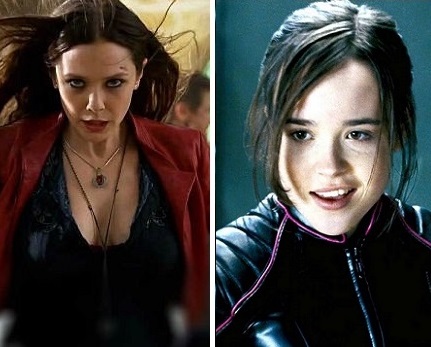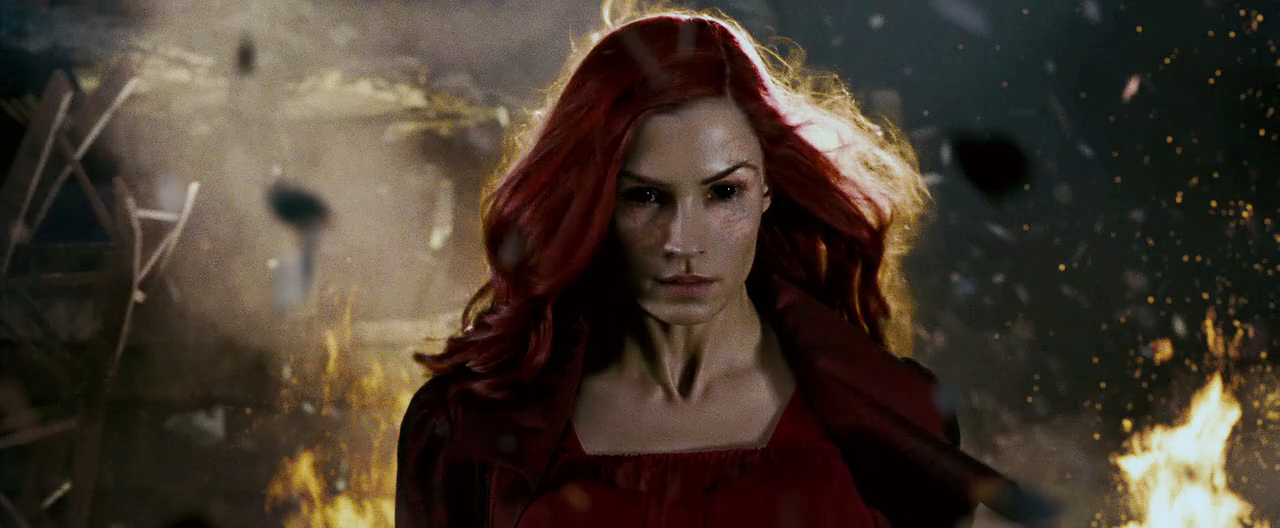This guest post written by Sophie Hall appears as part of our theme week on Superheroines.
Captain America: Civil War was released earlier this month, marking it as Marvel’s 13th feature film and it satisfied critics and audiences alike. Not only did it pass the billion dollar gross mark, it passed the DuVernay test, having not two but three Black superheroes (Falcon, War Machine, and introducing Black Panther), making it one of the few superhero films to do so.
Sadly though, the film was let down by its superheroines (and I’m not just talking about it failing the Bechdel test.) The two female superheroes we are presented with are Black Widow/Natasha Romanoff and Scarlet Witch/Wanda Maximoff; don’t get me wrong, both are distinguished heroines in a film overstuffed with testosterone, with the filmmakers taking their time with them in establishing their flaws, strengths, vulnerabilities and powers. The problem, then? The pair are similar in race and religious ambiguity — and they shouldn’t be. While Black Widow’s portrayal remains true to her comic book origin, Scarlet Witch’s does not, as her comic book counterpart is Romani and Jewish.
In a featurette for the film Avengers: Age of Ultron, actress Elizabeth Olsen who portrays Scarlet Witch states that writer/director Joss Whedon “is really interested in creating another female character that is strong” for his sequel. This is understandable; Black Widow had been the only prominent female character thus far to receive any sort of a storyline outside of being a love interest or revolving solely around a man.
[youtube_sc url=”https://www.youtube.com/watch?v=33dnL_TSP5k”]
However, given the fact that the whole team (at this point), including Black Widow are white and religiously ambiguous, why did Whedon feel that Judaism and a ‘strong female character’ were mutually exclusive? Whedon could have used Scarlet Witch’s Romani heritage as a visual and cultural exploration of her powers, benefiting her character as on the whole.
Not only does Whedon erase Scarlet Witch’s religion in his portrayal — he has her go against it. When the audience is first introduced to Scarlet Witch’s character in Age of Ultron, we discover that she and her twin brother Quicksilver have willingly volunteered to be experimented on for the Nazi organization Hydra to gain powers. Their motivation for this was so that they could seek revenge on Iron Man/Tony Stark, whom they feel is responsible for the death of their parents — but does the end of this narrative choice justify the means? Because that’s a huge creative license to reconcile with the superheroine’s comic book origins.
Some may see keeping Scarlet Witch’s Jewish heritage as not only a duty, but a necessity, if she is to be an Avenger under Captain America’s leadership. In an article on Captain America’s character conception, Jessica Plummer at Panels writes:
“He was famously depicted punching out Adolf Hitler on the cover of his first appearance, in Captain America Comics #1 — which hit stands in December 1940, a full year before Pearl Harbor and before the United States joined World War II, making that cover a bold political statement. […]
“Like most of the biggest names in the Golden Age of comics, they [Captain America creators] were Jewish. They had family and friends back in Europe who were losing their homes, their freedom, and eventually their lives to the Holocaust. The creation of Captain America was deeply personal and deeply political.”
Not only is erasing Judaism a disservice to both Scarlet Witch and Captain America, it’s also disrespectful to the Jewish writers who invested so much in making a statement about Jewish resistance in their artistic expression. With these brave Jewish writers using their art to combat anti-Semitism, respect and inclusion of the religion should always outweigh a filmmaker’s personal creative preference.
Similarly to Scarlet Witch, another superheroine whose Judaism has been erased in their cinematic portrayal is Kitty Pryde/Shadowcat of the X-Men universe. In the comics, Kitty Pryde is a feisty, spirited, and proudly Jewish member of the X-Men. Yet disappointingly in her 2006 big screen debut in X-Men: The Last Stand, her religion is never mentioned and she’s part of a love triangle designed to progress the character of Bobby Drake/Iceman.
What’s aggravating about the omission of Kitty Pryde’s faith is the fact that the filmmakers didn’t do this to Magneto’s character (who ironically is Scarlet Witch’s father in the comics.) The Jewish faith was necessary for them to progress a male character’s storyline but not for a female character. Supervillains can keep their faith whereas superheroines can’t.
Kitty Pryde and Scarlet Witch went on to have another screen outing each, but their faith was still nowhere to be seen. Civil War did a great job at progressing Scarlet Witch’s character (read Maddie Webb’s brilliant Bitch Flicks article). However, without her faith, she is just another white superheroine alongside Black Widow and Sharon Carter, adding nothing new for viewers to take in.
Where Scarlet Witch was blessed with complexity, Kitty Pryde was cursed with none in her on-screen follow up, X-Men: Days of Future Past. In the comic book storyline on which the film is based, it is Kitty who travels back in time to stop the sentinels from creating an apocalyptic-like future in wiping out not only mutants, but most of humanity. The film adaptation? Of course it was Wolverine sent back, a reliable character for a box office draw. Not only was this a missed opportunity for a superheroine to truly shine on the big screen, but the filmmakers missed out on a more poignant story. Kitty Pryde would have faced what her ancestors faced generations ago; where they were targeted for their religion, Kitty was now being targeted for her mutation. The story would have showcased a seemingly endless cycle that this heroine actively fights to end.
More troubling still was who replaced Kitty Pryde as the female lead in X-Men: Days of Future Past; the blonde haired, blue eyed (and occasionally blued skinned) Mystique, played by global superstar Jennifer Lawrence. Critic Helen O’Hara at Digital Spy highlights the inconsistency of making Mystique the leading superheroine of the recent X-Men films:
“It’s a sea change for the character. In the entire history of the comics she joined the X-Men precisely once, only to betray them almost immediately and reveal herself as a double-agent. During the comics’ Age Of Apocalypse saga, she at least didn’t work against them, but she was basically a war profiteer, ferrying mutants to safety in return if they could afford the price.”
Likewise with Wolverine taking Kitty’s role in the film, it’s easy to see why Mystique would be given center stage over her character. Jennifer Lawrence has an Oscar and the Hunger Games franchise under her belt, proving that she too is reliable in filling seats in a cinema. Still, the studio replacing a pivotal Jewish heroine with two reliable crowd pleasers goes to show how easily they will forgo significant storytelling for easy money.
Given the overall treatment of Scarlet Witch and Kitty Pryde, will we ever see diversity progress for superheroines? In the newest X-Men entry, X-Men: Apocalypse, the front and center superheroine is again Mystique, with Jean Grey appearing as her ally. However, the film poises the two women of color (Storm and Psyclocke) as the antagonists; seeing as the white western heroines are the heroes, you can guess who will most likely dominate the screen-time. The female characters who are minorities get sidelined while the white superheroines shine.
For Disney owning two franchises, they are much slower with female diversity in Marvel than with Star Wars. Granted, the heroines in The Force Awakens were white, but the follow-up Episode 8 will have another female lead played by Asian-American actress Kelly Marie Tran. That will be Disney’s third Star Wars feature, whereas Marvel still only has white women as lead and supporting characters in their 13th feature, which is why Scarlet Witch’s Jewish identity was missed more than ever.
On the other hand, Lupita Nyong’o has been cast in an unspecified (but hopefully badass) role in the upcoming Black Panther film. The character of Valkyrie will be played by the talented Tessa Thompson in the upcoming Thor sequel (presumably due to the backlash of Tilda Swinton’s casting in the upcoming Doctor Strange film). However, I still can’t help but feel a bit bittersweet about this; we should already be basking in the afterglow of diverse heroines, instead of playing what seems like a never-ending waiting game.
See also at Bitch Flicks: Why Scarlet Witch May Be the Future of the Marvel Cinematic Universe
Sophie Hall is from London and has graduated with a degree in Creative Writing. She is currently writing a sci-fi comic book series called White Leopard for Wasteland Paradise Comics. Her previous articles for Bitch Flicks were on Mad Max: Fury Road, Star Wars: The Force Awakens, director Andrea Arnold and Game of Thrones. You can follow her on Twitter at @sophiesuzhall.










